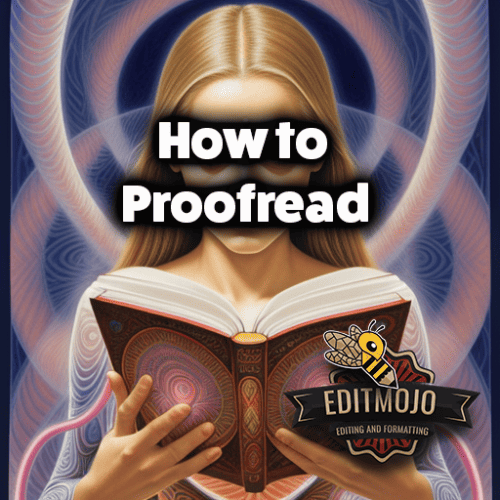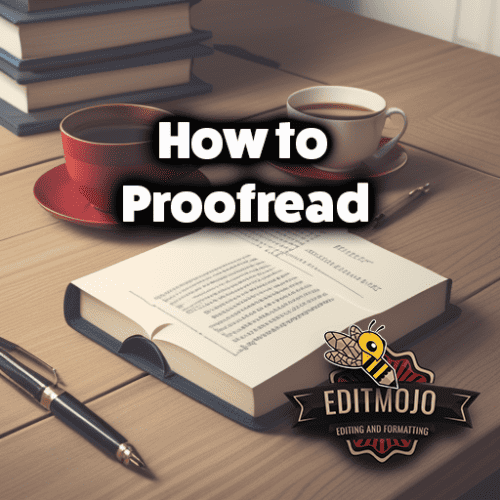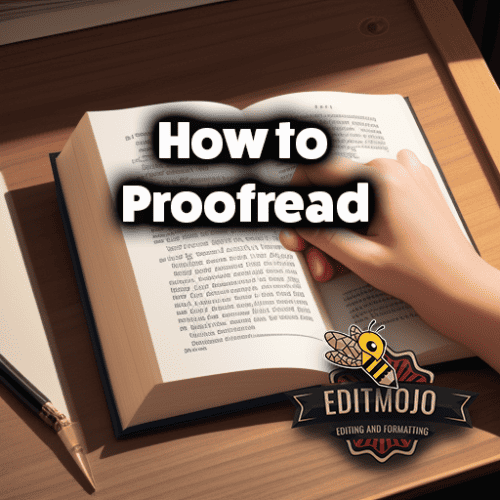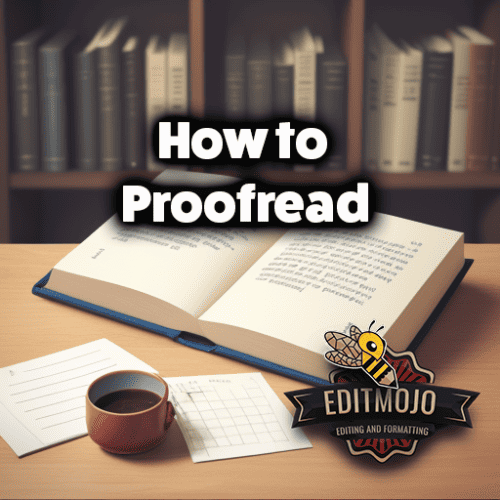How to Proofread
How to Proofread and Polish a Book: A Comprehensive Guide for Aspiring Authors. There’s an oft-quoted saying in the world of writing that goes, “The first draft of anything is sht.”* While a tad crude, this nugget of wisdom from Ernest Hemingway underscores a crucial point—writing is, by nature, a process. A process that requires considerable proofreading and polishing to turn that initial idea into a well-crafted masterpiece. This article will dive into the art and science of proofreading and polishing your book to perfection. So, buckle up for this literary journey and let’s get started.
Key Takeaway Table
| Key Points | Takeaways |
|---|---|
| Difference Between Proofreading and Editing | Editing focuses on refining the content and structure, while proofreading involves checking for grammatical, typographical, and formatting errors. |
| Multiple Drafts | Writing is a process, and multiple drafts are necessary for refining and polishing your work. |
| Polishing Techniques | Revising for clarity, sharpening dialogue, enhancing character development, streamlining plot, and incorporating imagery are key steps in polishing a book. |
| Proofreading Techniques | Reading aloud, using grammar tools, reading on paper, and reading backward can help catch errors. |
| Professional Help | Professional editors and proofreaders provide an unbiased perspective and can catch errors you may have missed. |
| Beta Readers and Writing Groups | These provide valuable feedback from a reader’s perspective and a supportive community for writers. |
| Proofreading and Polishing Mindset | It’s a mindset of constant learning and improvement, not just a task. |
Understanding the Difference Between Proofreading and Editing
Before we embark on the nitty-gritty, it’s important to distinguish between editing and proofreading. Editing is a process that involves restructuring content, refining arguments, and clarifying meaning. It’s like chiseling a rough slab of marble into a rough approximation of a statue.
On the other hand, proofreading is the final stage, where you scrutinize the text for any typographical, grammatical, or punctuation errors. It’s akin to sanding and polishing the statue to reveal its final, beautiful form. These two steps, while distinct, are interconnected and pivotal in the creation of your literary masterpiece.

The Necessity of Multiple Drafts
Mark Twain once said, “The time to begin writing an article is when you have finished it to your satisfaction.” In other words, your first draft is just the beginning. This is where you get your ideas out, a sort of brain dump, if you will. It’s raw, it’s messy, and that’s perfectly fine.
Revisions are where the magic happens. Each draft refines your idea and brings clarity to your work. It’s akin to the process of making a sculpture, where each revision chips away at the raw material until a refined figure begins to emerge. Don’t fear this process—embrace it.
Steps in Polishing a Book
Polishing your book is an exercise in refinement. It’s about making your story, characters, and language shine. Here’s how:
1. Revising for Clarity and Consistency: Ensure your thoughts flow logically and consistently. Check that your world-building elements and character attributes remain consistent throughout the story.
2. Sharpening Narrative and Dialogue: Dialogue should feel natural and contribute to character development or plot progression. Your narrative should captivate and hold the reader’s interest.
3. Enhancing Character Development and Setting: Your characters need to evolve throughout the story, and your settings should be vivid and immersive.
4. Streamlining Plot and Pacing: The story should have a good balance of action and reflection, and the pace should align with the genre and plot demands.
5. Incorporating Sensory Details and Imagery: Rich, evocative descriptions engage readers and make your world feel real.
Understanding Proofreading
Proofreading is all about the details. It’s the final check you perform before your book is ready to face the world. Here, you’re looking for any errors in grammar, punctuation, spelling, and formatting that might have slipped through. Attention to detail is crucial here—misspelled words or incorrect grammar can pull readers out of your carefully crafted world.

Practical Proofreading Techniques
Proofreading is an art that requires a keen eye and patience. Here are some techniques that can help:
1. Reading Aloud: This forces you to slow down
and can help catch errors that you might skim over when reading silently.
2. Using Technology: Tools like Grammarly can help catch grammar and spelling errors.
3. Print it Out: Reading on paper gives a different perspective and can make it easier to spot mistakes.
4. Reading Backward: Starting at the end and reading backward disrupts your understanding of the content, making it easier to catch errors.
Professional Help: When and Why to Consider It
While self-proofreading is essential, there’s also a place for professional help. A professional editor or proofreader brings an unbiased perspective to your work and can catch errors or inconsistencies that you may have missed. Websites like Reedsy can connect you with experienced professionals.
The Importance of Beta Readers and Writing Groups
Never underestimate the value of fresh eyes. Beta readers provide valuable feedback from a reader’s perspective. Writing groups can provide critique and camaraderie. Platforms like Goodreads and Scribophile are great for finding beta readers and writing groups.
EditMojo.com: Embodying the Mindset of Proofreading and Polishing
At EditMojo.com, we believe that proofreading and polishing is far more than a mere task—it’s an entire mindset. For us, it involves pursuing perfection with relentless determination, being patient enough to seek out and rectify mistakes, and cultivating a sense of pride in the meticulousness of our craft. It’s a journey of perpetual learning and enhancement, akin to that of renowned author J.K. Rowling, who undertook multiple drafts and many years of revisions to craft the globally cherished universe of Harry Potter.
EditMojo.com understands that this craft is not easily mastered, which is why we provide essential resources to aid in your proofreading and polishing journey. Books like “Self-Editing for Fiction Writers” by Renni Browne and Dave King, and “The Elements of Style” by William Strunk Jr. and E.B. White are readily recommended for their insightful guidance on refining your writing.
We also acknowledge the role of digital tools in today’s writing world. Therefore, we advocate for the use of applications such as Grammarly, Hemingway App, and ProWritingAid to automate and simplify the process of checking grammar and style.
To further enhance your skills, we suggest enrolling in courses offered by platforms like Masterclass, Coursera, and Udemy. These platforms provide comprehensive tutorials that can transform you into a proficient proofreader and editor.
Proofreading and polishing a piece of writing is an art that requires time, dedication, and an immense amount of patience. However, the final result—a polished, engaging, and well-structured piece of writing—is truly worth every bit of the effort. At EditMojo.com, we urge you to embrace the process, for it is within this journey that you will find significant growth as a writer.

Proofreading and Polishing: A Mindset Not a Task
Polishing and proofreading isn’t just a task—it’s a mindset. It’s about seeking perfection, having the patience to find and fix errors, and taking pride in your craft. It’s a journey of constant learning and improvement, much like the journey of J.K. Rowling, who went through numerous drafts and years of revision to create the beloved world of Harry Potter.
Essential Resources for Proofreading and Polishing
Here are some resources to aid you in your proofreading and polishing journey:
- Books: “Self-Editing for Fiction Writers” by Renni Browne and Dave King, “The Elements of Style” by William Strunk Jr. and E.B. White.
- Tools: Grammarly, Hemingway App, ProWritingAid.
- Courses: Masterclass, Coursera, Udemy.
Proofreading and polishing a book is an art that takes time and patience to master. But the result—a well-crafted, engaging, and polished piece of writing—is worth the effort. So, embrace the process, for it is here that you truly grow as a writer.
Don’t be daunted by the thought of making your work perfect. As the legendary author Neil Gaiman aptly put it, “Remember: when people tell you something’s wrong or doesn’t work for them, they are almost always right. When they tell you exactly what they think is wrong and how to fix it, they are almost always wrong.” Your book is your work of art. So, proofread, polish, and then let it shine.
Common Misconceptions about Proofreading and Polishing
Despite their importance, proofreading and polishing are often misunderstood. Let’s debunk some myths:
1. “Good Writers Don’t Need to Proofread”: Every writer, no matter how skilled, can make mistakes or overlook details. Moreover, proofreading isn’t only about errors; it’s about perfecting your manuscript.
2. “A Quick Read-Through Is Enough”: Proofreading requires a systematic approach, attention to detail, and often multiple passes through the text.
3. “Computer Spell Checkers Are Sufficient”: While useful, spell checkers are no substitute for a careful, human review. They can miss context-specific errors, homonyms, or awkward phrasing.
Don’t let these misconceptions deter you. Remember, the goal of proofreading and polishing is not to attain some illusory idea of perfection but to make your work the best it can be.

Case Study: Proofreading and Polishing in Action
To understand the impact of proofreading and polishing, let’s look at a real-life example: J.D. Salinger’s classic, The Catcher in the Rye. Salinger reportedly spent ten years writing and revising the novel. He was known to be a meticulous writer, often spending months on a single paragraph. This level of commitment to the revision process is evident in the final product, which is lauded for its narrative voice and character development. This illustrates how proofreading and polishing can elevate a work from good to great.

Call to Action
And that wraps up our comprehensive guide on how to proofread and polish your book. Remember, every great piece of writing you’ve ever admired has undergone this rigorous process. The journey might seem long and sometimes challenging, but the results are always worth it. Your stories deserve to shine, and with careful proofreading and diligent polishing, they will.
So, why not start your proofreading journey today? Share your experiences, tips, or any questions you have in the comments section below. Let’s create a community where we can learn from and support each other in our writing journeys. And don’t forget to subscribe or follow for more content that will help you become the best writer you can be!
With each word you write, remember this quote by Thomas Mann: “A writer is someone for whom writing is more difficult than it is for other people.” Embrace the struggle, for it is the crucible in which great writing is forged. Now, go forth and let your words change the world!
Top Five Questions and Answers Table
| Questions | Answers |
|---|---|
| What’s the difference between proofreading and editing? | Editing focuses on refining content and structure, while proofreading checks for grammatical, typographical, and formatting errors. |
| Are multiple drafts necessary? | Yes, writing is a process, and multiple drafts are necessary for refining and polishing your work. |
| What are some polishing techniques? | Revising for clarity, sharpening dialogue, enhancing character development, streamlining plot, and incorporating imagery are key steps in polishing. |
| What are some proofreading techniques? | Reading aloud, using grammar tools, reading on paper, and reading backward can help catch errors. |
| When should I consider professional help? | Professional editors and proofreaders can catch errors you may have missed and provide an unbiased perspective. It’s worth considering if you want to ensure your work is the best it can be. |
Top Seven Resources and Further Reading Table
| Resources | Description |
|---|---|
| Self-Editing for Fiction Writers by Renni Browne and Dave King | A book offering practical advice to refine your manuscript. |
| The Elements of Style by William Strunk Jr. and E.B. White | A classic guide to English language principles. |
| Grammarly | An online grammar checking tool. |
| Hemingway App | A tool that highlights complex sentences and common errors. |
| Masterclass | Online writing courses taught by renowned authors. |
| Coursera | Online platform offering writing courses from top universities. |
| Udemy | Offers a variety of writing courses across different genres. |
Book editing requires a balance between respecting the author’s voice and ensuring clarity and consistency throughout the narrative.
